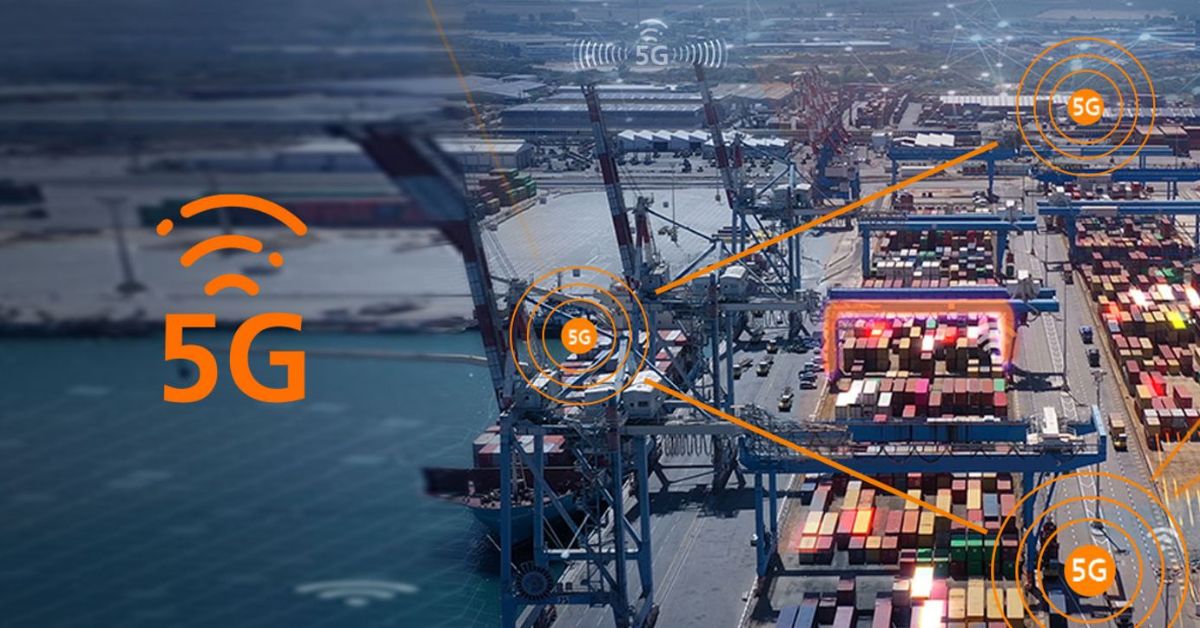Around 76 per cent of global port operators now cite yard and terminal optimization as their top priority, according to Port Technology. At the same time, 22 per cent believe that enhanced asset monitoring — made possible by real-time data and automation — can help mitigate economic and business pressures. With congested yards creating inefficiencies and environmental challenges, automation driven by 5G is emerging as the essential solution.
5G networks offer ultra-low latency, high bandwidth, and massive device connectivity, making them ideal for mission-critical industrial applications. Ports around the world are leveraging 5G for a range of use cases: remote-controlled ship-to-shore cranes, automated guided vehicles (AGVs), rubber-tired gantry cranes, predictive condition monitoring, and drone-based surveillance and deliveries.
These smart systems allow operators to improve safety by reducing human exposure to hazardous environments, enhance equipment uptime through real-time diagnostics, and achieve greater productivity and cost-efficiency. A 5G private network also consolidates all communication into a single, secure backhaul, eliminating the need for multiple fragmented systems.
With its ability to support high connection density and seamless communication, 5G is laying the foundation for industrial IoT in ports. As more global terminals adopt this technology, the benefits — from reduced congestion to lower emissions and faster cargo movement — are rapidly becoming undeniable. The digital port revolution has arrived, and 5G is at its helm.
India’s vast coastline and strategic location offer immense potential to become a global maritime powerhouse. With over 12 major ports and more than 200 non-major ports handling millions of tonnes of cargo annually, Indian ports are vital nodes in global trade. However, to compete with world-class ports such as Singapore, Rotterdam, or Shanghai, Indian ports must make a critical technological leap — by embracing 5G communication networks to power the next generation of smart port operations.
The current landscape: Lagging in connectivity and smart infrastructure
Indian ports have made strides in automation and digitalisation, but progress remains uneven. Ports like Jawaharlal Nehru Port Authority (JNPA) and Mundra have implemented partial automation, especially in container handling. However, many others still rely heavily on manual operations, leading to inefficiencies, slow turnaround times, and higher operational costs.
Outdated port infrastructure and poor connectivity with hinterland logistics create bottlenecks that hamper cargo flow. Compounding these challenges is the lack of high-speed internet connectivity. Most ports still operate on legacy networks, limiting their ability to integrate Internet of Things (IoT) devices, artificial intelligence (AI), and real-time analytics — the very technologies that underpin global smart port ecosystems.
Moreover, regulatory fragmentation and the absence of structured incentives discourage private investments in advanced technologies like 5G and AI-driven systems. Without targeted reform, Indian ports risk falling further behind in a rapidly digitizing global maritime sector.
Why 5G is the game-changer for port operations
The rollout of 5G networks offers Indian ports a transformative opportunity. Unlike previous generations of mobile communication, 5G offers ultra-low latency, high-speed data transfer, massive device connectivity, and real-time responsiveness — essential features for automating complex port functions.
With 5G, ports can:
- Enable real-time cargo tracking and predictive analytics.
- Deploy autonomous vehicles and equipment safely and efficiently.
- Enhance cybersecurity and remote monitoring capabilities.
- Coordinate seamlessly with logistics providers, customs, and shipping lines.
5G will also improve worker safety, reduce human error, and significantly cut operational costs by driving data-driven decision-making.
Building the 5G-ready Indian port: Strategic steps forward
To bring Indian ports to global standards in 5G-enabled smart operations, a comprehensive, multi-stakeholder approach is necessary. Here are the key steps:
Infrastructure overhaul and network deployment
Indian ports must partner with telecom providers like Reliance Jio, Airtel, and Vodafone Idea to build dedicated 5G infrastructure. This includes:
- Installation of 5G small cells and towers across port zones.
- Deployment of edge computing systems for real-time data processing.
- Upgradation of existing optical fibre networks and cloud data centres.
Ports located in remote or less developed regions should receive priority funding to bridge the connectivity gap and ensure uniform access to high-speed networks.
Robust policy and regulatory support
A clear national policy for 5G deployment in ports is crucial. The government must:
- Simplify licensing and spectrum allocation processes.
- Introduce financial incentives, tax breaks, and capital subsidies for ports investing in 5G infrastructure.
- Promote uniform adoption by establishing national standards for 5G-enabled port operations, ensuring seamless integration with global supply chains.
Collaboration between the Ministry of Ports, Shipping and Waterways, Department of Telecommunications, and private sector stakeholders will be essential to coordinate efforts.
Integration of IoT, AI, and automation
The 5G ecosystem should enable ports to become intelligent operational zones by integrating:
- IoT devices: For real-time tracking of cargo, equipment condition monitoring, and environmental sensors.
- Autonomous systems: Including cranes, trucks, and vessels for reduced reliance on manual labour and enhanced operational safety.
- AI and predictive analytics: For berth scheduling, yard planning, inventory management, and proactive maintenance.
Such technologies, when synchronised over a 5G network, dramatically boost efficiency, reduce delays, and lower emissions.
Capacity building and workforce reskilling
Technology is only as effective as the people who use it. Indian ports must prioritize:
- Training programs to upskill workers in 5G operations, data analytics, and automation technologies.
- Collaborations with tech companies, startups, and academic institutions to develop customized skilling initiatives in AI, machine learning, and digital port operations.
A digitally fluent workforce will accelerate adoption and ensure sustained performance improvements.
Public-Private Partnerships (PPPs) as catalysts
The capital-intensive nature of 5G deployment makes PPPs critical. Indian ports should:
- Form joint ventures with telecom operators to co-develop infrastructure.
- Leverage government schemes like Sagarmala for financial backing of smart port projects.
- Seek international collaboration with ports that have successfully implemented 5G, such as PSA Singapore and Port of Antwerp, to adapt global best practices to the Indian context.
Navigating Challenges: Cost, cybersecurity, and interoperability
The transition to 5G is not without hurdles. Key challenges include:
- High capital investment: Smaller ports may struggle with the cost burden of upgrading systems and deploying infrastructure. A phased rollout supported by subsidies and private investment can help mitigate this.
- Cybersecurity risks: A 5G-connected port becomes a cyber target. Implementing global security standards, real-time threat detection, and continuous monitoring will be critical.
- System integration issues: Many Indian ports operate on legacy IT systems, making interoperability with new 5G technologies a concern. Ports must conduct compatibility audits and adopt modular solutions that ensure seamless transition.
A vision for the future: Global-standard Indian ports
India has a golden opportunity to reimagine its port ecosystem. By adopting a phased and strategic approach to 5G implementation — starting with pilot programs in flagship ports and expanding nationally — Indian ports can elevate their global competitiveness.
5G-driven smart ports will:
- Reduce congestion and turnaround times.
- Improve visibility and coordination across the supply chain.
- Boost investor confidence in port-led industrial development.
- Contribute significantly to India’s $5 trillion economy vision.
Conclusion
The road to transforming Indian ports into global-class smart ports powered by 5G is both challenging and rewarding. With strategic vision, stakeholder collaboration, and technology-led reform, India can position its ports at the forefront of the digital maritime economy. The time to act is now — to harness the power of 5G and script a new era of intelligent, agile, and sustainable port operations.









